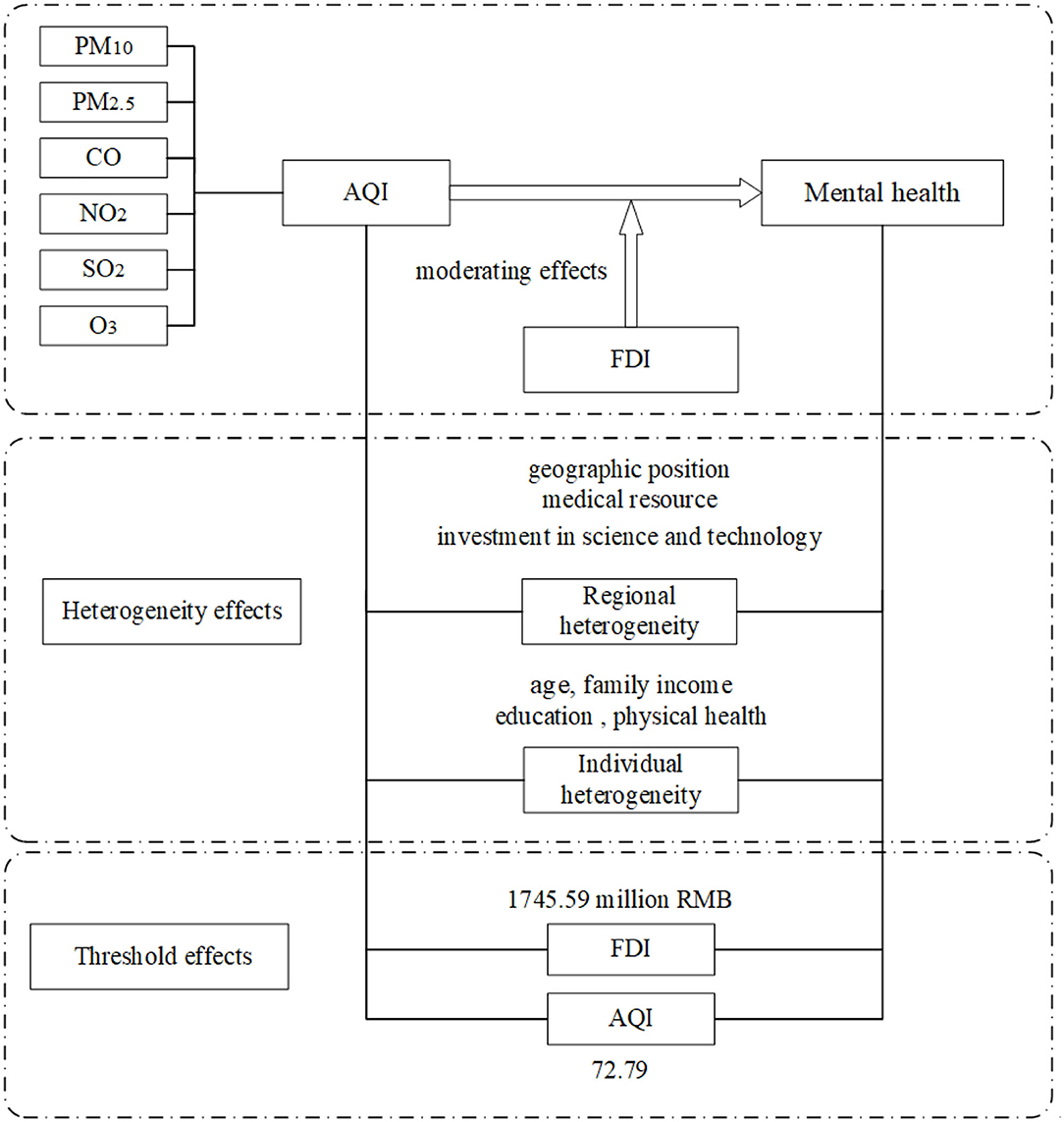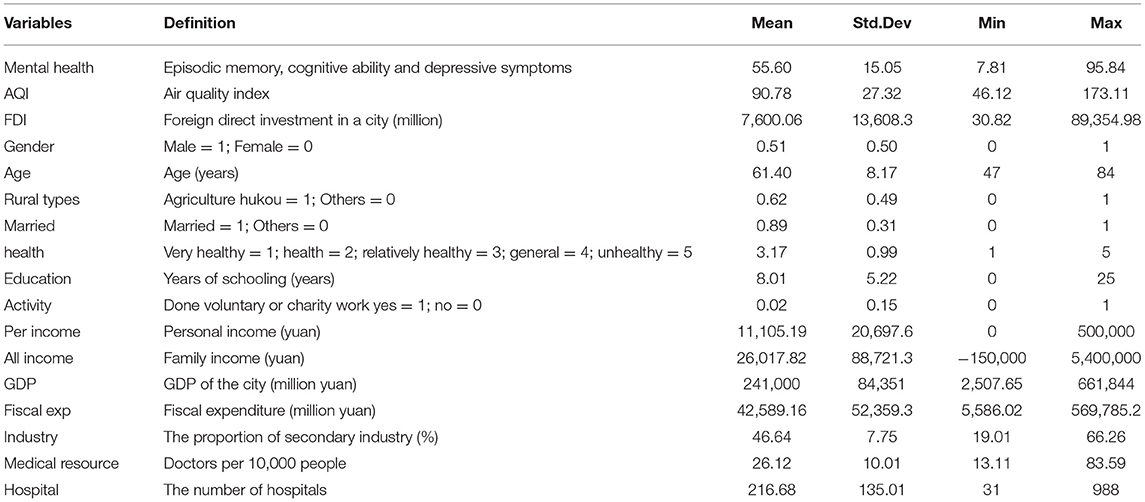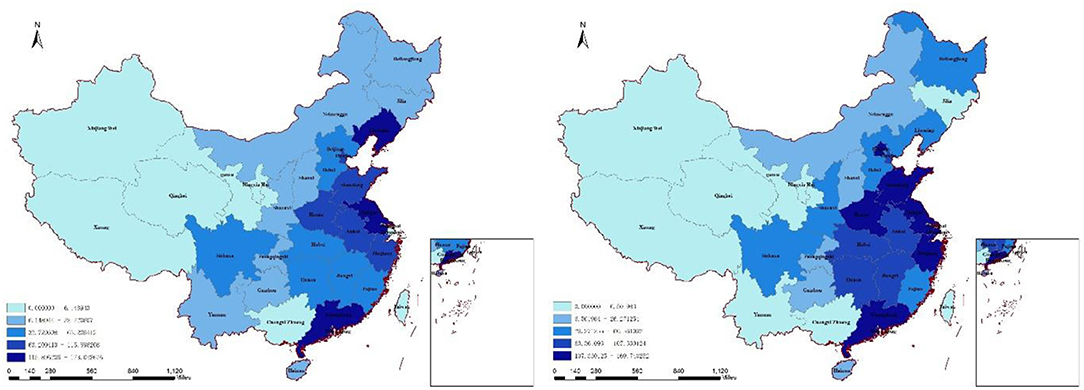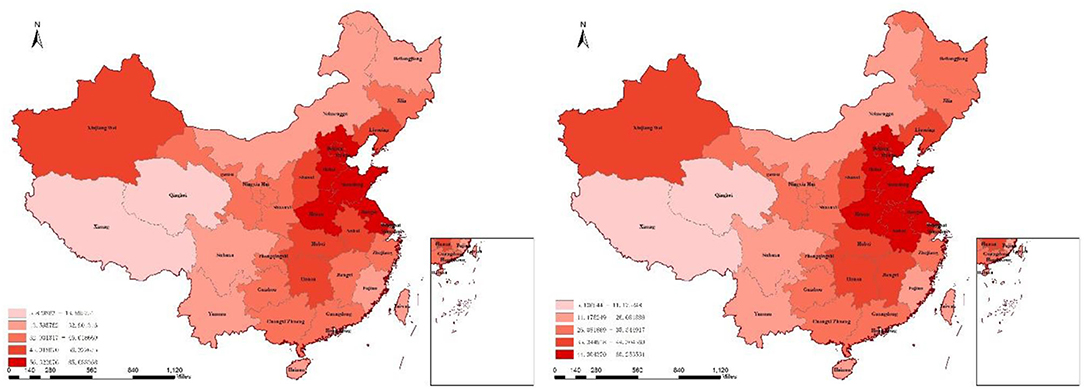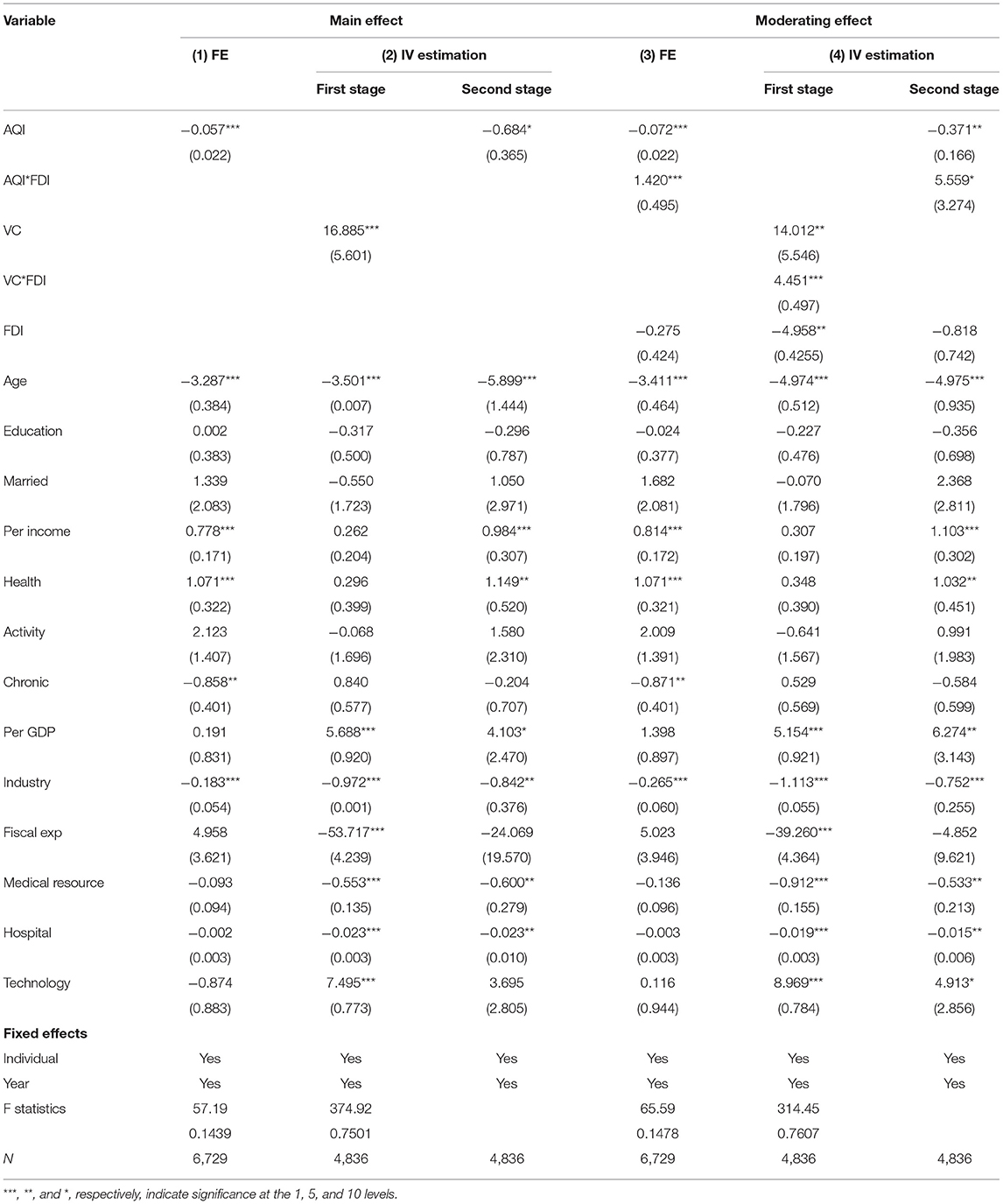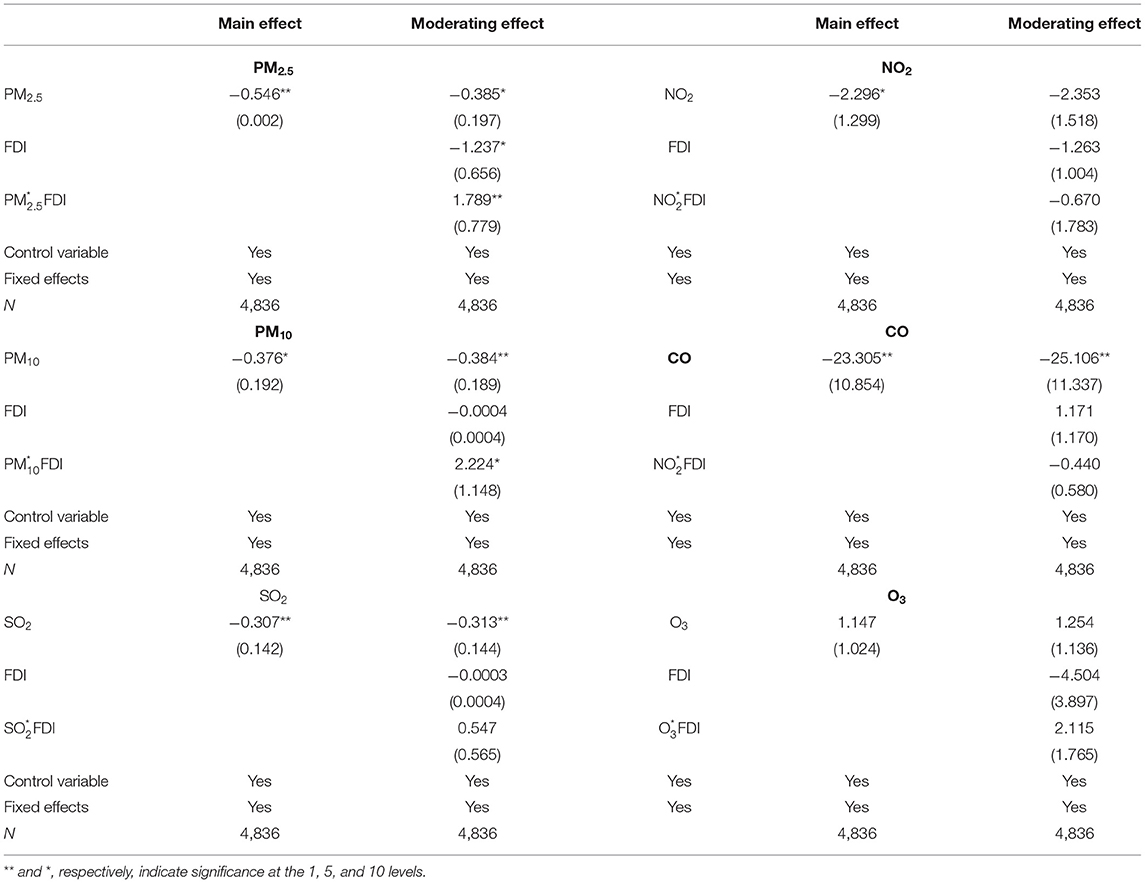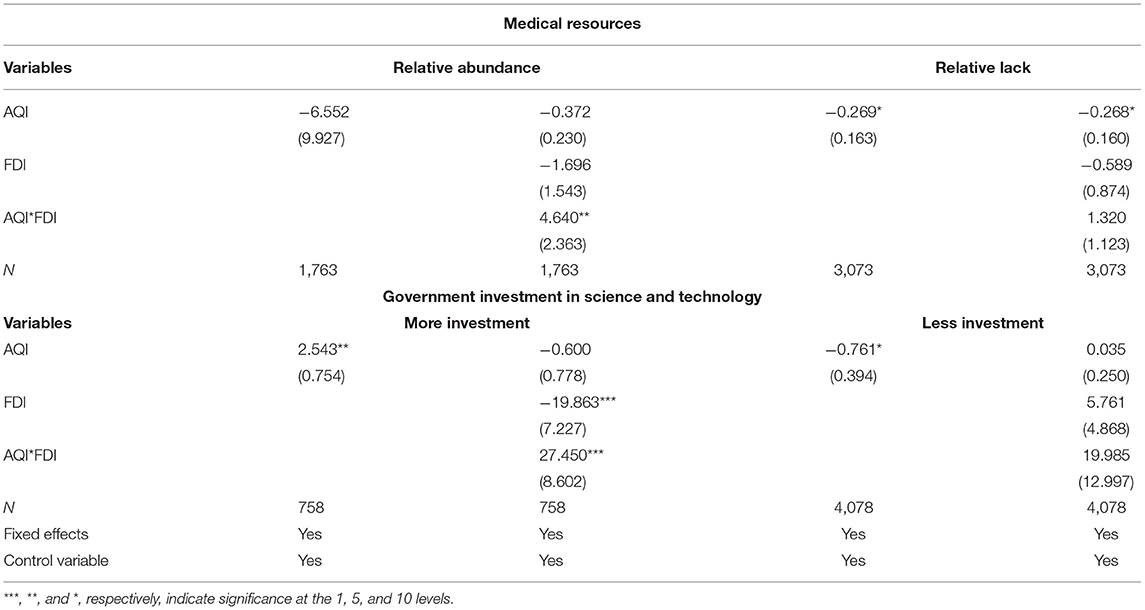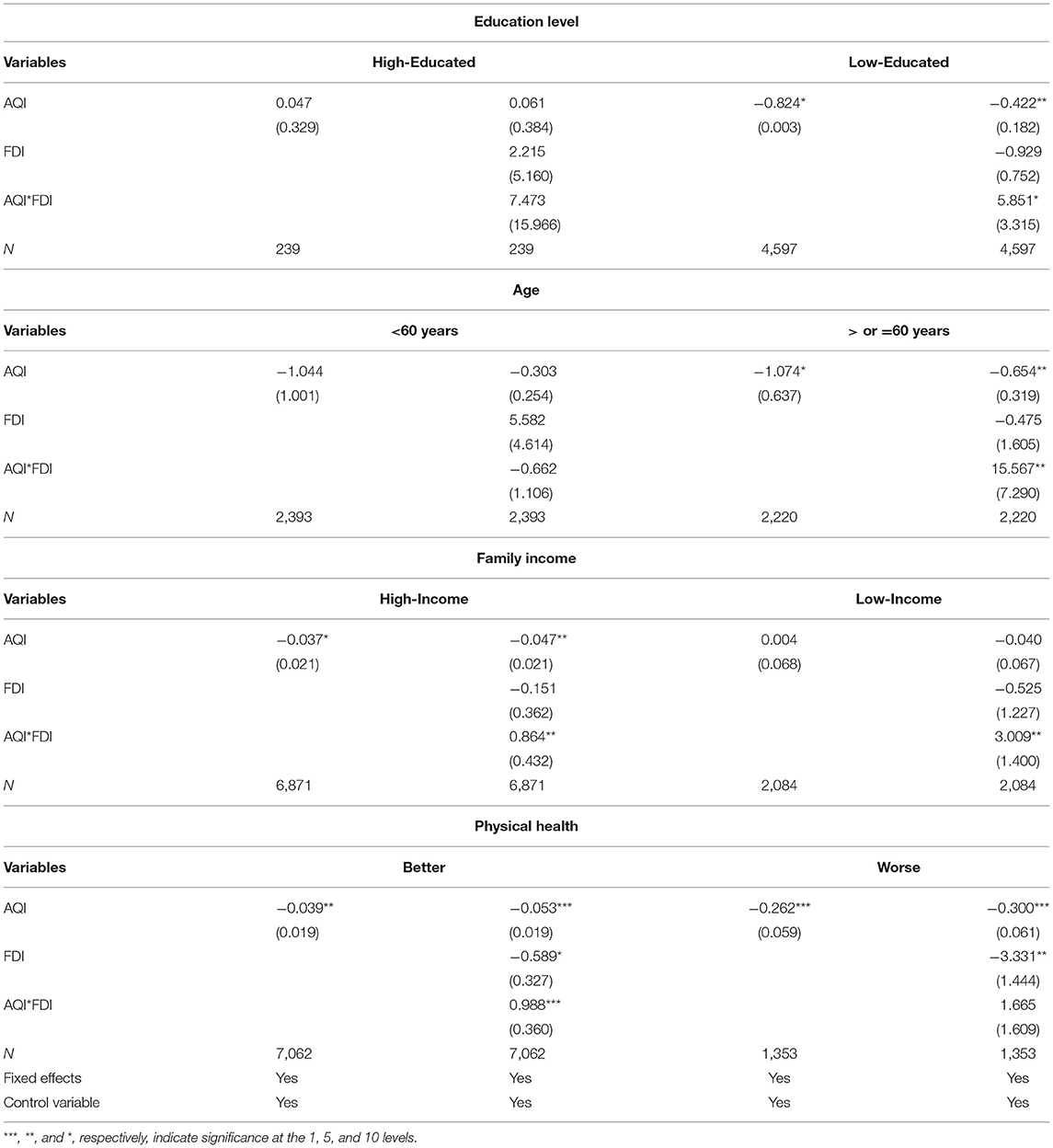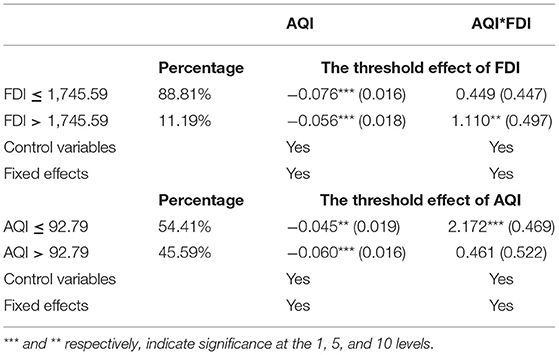- 1School of Economics, Qingdao University, Qingdao, China
- 2School of Economics, Shanghai University, Shanghai, China
Recently, there has been interest in the relationship between mental health and air pollution; however, the results are inconsistent and the contribution of foreign direct investment (FDI) has received little attention. This article studies the effects of air pollution on mental health and the moderating role of FDI based on the China Health and Retirement Longitudinal Study (CHARLS) data in 2015 and 2018 applying the fixed effects panel regression approach and the threshold model. The results show that mental health is adversely affected by air pollution, especially PM2.5, PM10, sulfur dioxide (SO2), carbon monoxide (CO), and nitrogen dioxide (NO2). Second, FDI has an alleviating influence on the negative relationship. Third, the effects of air pollution and FDI are heterogeneous based on regional characteristics, including location, medical resource and investment in science and technology, and individual characteristics covering education level, age, income, and physical health. Finally, the threshold effects show that FDI has a moderating effect when it is >1,745.59 million renminbi (RMB). There are only 11.19% of cities exceeding the threshold value in China. When the value of air quality index (AQI) exceeds 92.79, air pollution is more harmful to mental health. Government should actively introduce high-quality FDI at the effective level and control air pollution to improve mental health.
Introduction
Mental health, as an important public health challenge, has received increased attention, especially during coronavirus disease 2019 (COVID-19) outbreak. Mental health refers not only to cognitive ability and the absence of mental diseases, but also to a good mental state (1). Air pollution is concerned as one of leading ten risk factors for human (2), mainly including particulate matter (PM2.5 and PM10), carbon monoxide (CO), nitrogen dioxide (NO2), sulfur dioxide (SO2), and ozone (O3). Air pollution can increase the mortality, subjective illness, and medical and psychological problems (3–6). There were 6.67 million deaths worldwide due to air pollution according to the Global Burden of Disease Report 2019. Numerous studies have examined the impacts of air pollution on physical health (7). In recent years, there has been a surge of interest in the effects of air pollution on mental health (8, 9). The incidences of mental illness will increase 6.67%, if the concentration of PM2.5 increases a one SD (10).
China, the focus of this study, is one of countries with serious air pollution in the world. A large number of air pollutants are brought by rapid economic growth. In China, 135 cities have exceeded environmental air quality standard, accounting for 40.1% of the total 337 cities according to 2020 China Ecological and Environmental Quality Bulletin. The World Health Statistics 2021 reports that air pollution has caused 112.7 deaths per 100,000 population in China in 2016. The elderly and children, who are more vulnerable to air pollution (11, 12), have attracted considerable scholarly attention (13). Therefore, we study the effects of air pollution on mental health, including memory, cognitive ability, and emotions of middle-aged and elderly residents. A better understanding of different influences of air pollution would help to put forward the corresponding countermeasures and reduce adverse effects on health. The results also have implications for other developing countries.
Although previous studies have shown the relationship between mental health and air pollution, there are some inconsistent findings (14). The answers to the above questions and the moderating role of foreign direct investment (FDI) need to be further studied and judged in the light of China's current situation. In addition, it is challenging to accurately identifying the relationship between mental health and air pollution because of endogenous problems. The first is reverse causality. Mental illness may lower labor supply (15) and make workers less productive (16), which, in turn, also affects air pollution caused by economic activities. The second is measurement error of air pollution, which will bias the estimated results (17). We instrument air pollution using the ventilation coefficient to avoid the endogenous biases (18).
In addition, there has been little discussion about the moderating effect of FDI on this nexus. China has witnessed a rapidly growing economy since the reform and opening-up. A large number of FDI play an important role during the period. China has become the largest country in foreign capital inflows owing to a series of preferential policies. Global FDI plunged by 42% to $859 billion in 2020, while FDI in China bucked the decreasing trend and rose to $163 billion. China has ranked as the largest counties of foreign capital inflow, surpassing the United States for the first time according to the Organization for Economic Cooperation and Development. Economic growth in China owes too much large inflows of FDI and its impacts on environment have gradually become a topic. On one hand, FDI could increase the investment of residents and government in mental health through promoting economic growth and arousing the awareness against pollution. Income level is associated with affordability for health investment, thus influencing mental health. On the other hand, China's government has encouraged more FDI to flow into the high-tech industry in recent years. These FDI supports the “pollution halo” hypothesis, which will also help to alleviate the effect of air pollution. Therefore, we study the influence of FDI to have a better understanding of the influencing mechanism of air pollution on mental health.
This article makes several contributions. First, we use entropy weight method to construct the mental health index, which consists of episodic memory, cognitive ability, and depressive symptoms (Center for Epidemiologic Studies-Depression). According to the definition of the WHO, mental health includes not only the absence of mental diseases, but also a good cognitive ability and welfare state (1). Most studies on mental health refer to only one aspect such as happiness, depression, and life satisfaction (19, 20). Besides mental state, this study also investigates the impact of air pollution on the episodic memory and cognitive ability of residents. Although Shen et al. study the same three indicators as in this article, they used a simple arithmetic average method (7). The entropy method is based on the variation degree to avoid the deviation caused by human factors, which could evaluate mental health more accurately.
Second, prior studies neglected the moderating effect of FDI on the relationship between air pollution and mental health. Whether and how the effects of air pollution on mental health when FDI levels are considered become an empirical question. The role of FDI in the light of China's current situation is uncertain. This article attempts to fill the gaps in the literature.
Third, the effects of air pollution and FDI on mental health can be very diverse in regional and individual characteristics. Moreover, air quality index (AQI), as the measurement indicator of air pollution, is calculated as a composite indicator of PM2.5, PM10, CO, NO2, SO2, and O3. Different types of air pollution may differ in their characteristics. We study heterogeneity in the effects of air pollution and FDI on mental health not only including the difference of regional and individual characteristics, but also the different types of air pollutants. A deeper understanding of the effects of various types and characteristics can help guide policymakers in crafting appropriate strategies.
Finally, most studies only focus on the causal relationship between air pollution and mental health, but few attentions have been to explore the level at which AQI and FDI matter. To fill this gap in the literature, we adopt the threshold model. We study that the impact of air pollution on mental health partly depends on the levels of air pollution and the scale of FDI. It is important for local government to set air pollution standards and control the quantity of foreign investment.
This article has been organized in the following ways: Section Literature Review is the literature review. The data and the methodology are introduced in Section Data and Methodology. Section Empirical Results presents the results. Section Discussion discusses the significant findings and the final section concludes.
Literature Review
The first strand of the literature investigated the relationship between health and air pollution. A large number of studies have examined the effects of air pollution on physical health (7). They found that air pollution could lead to various diseases such as malignant tumor, asthma, lung cancer, and respiratory diseases (21, 22). Among these, the elderly and children are more vulnerable to air pollution (11, 12). In recent years, there has been a surge of interest in the effects of air pollution on mental health (8, 9). Air pollution affects mental health mainly in three ways: First, air pollutants cause depression and neurodegeneration by increasing oxidative stress and cardiac medical conditions in the body (23, 24). Second, air pollution damages physical health and reduces outdoor activities, thus increasing people's loneliness and anxiety. Third, air pollution leads to the loss of human capital, which results in lower income and, ultimately, lower life satisfaction. On empirical side, however, there are some inconsistent findings on the relationship between air pollution and mental health (25). Some found that air pollution has negative effects on mental health through causing depression, restlessness, and stress (21, 26–28). There are possible associations between particulates and suicide, schizophrenia, and psychosis (29–31). The results of Zijlema et al. showed positive relationship between air pollution and mental health (14). The answers to the above questions need to be further studied and judged.
The influence of FDI on the nexus between air pollution and mental health is still uncertain. FDI plays a role mainly through the three channels as follows. (1) Income channel. On one hand, the production process of FDI is increasing returns to scale and FDI will promote economic growth and raise the income level (32). Higher income level leads to higher affordability for health investments, thus improving mental health (33). On the other hand, FDI has a positive effect on wages of skilled workers in the host country, which aggravates the income gap between skilled and unskilled workers (34, 35). This will increase frustration and stress among unskilled workers and make them more easily affected by air pollution; (2) Medical resource channel. FDI can improve the supply of medical services in host countries by directly flowing into the health sector (36). In addition, the increase in FDI helps the local government to increase the revenue intake and invest more medical and health services, which will reduce adverse effects of air pollution on health (37); and (3) Environment channel. Some studies supported the “pollution heaven” theory (38, 39). This implies that low-quality FDI tends to flow to the host country with lower environmental standards, thus leading to deteriorating air quality (40, 41). Others proved the “pollution halo” effects. They argued that FDI could improve air quality through new technologies and green production, which could moderate the negative impact on mental health (42, 43).
Data and Methodology
Methodology
Main Effects Model
We adopted a panel dataset to consider individual heterogeneity. Therefore, this article uses the fixed effects regression model to study the effects of air pollution on mental health.
where i represents the individual, j is the city, mental healthijt is the mental health state of i who lives in city j on year t, AQIijt is air quality index representing air pollution, Xijt is control variables influencing mental health at the individual, household, and regional levels, γi is the individual fixed effect, and δt is the time fixed effects.
However, due to the endogeneity caused by reverse causation and measurement error, the effects of air pollution on mental health will be biased. Therefore, we adopt the two-stage least squares (2SLS) for IV estimation. The ventilation coefficient (VC) is chosen referring to Broner et al. (18), which is the product of wind speed (ws) determining horizontal diffusion rate and atmospheric boundary layer height (blh) determining the height which air pollution disperses. On one hand, the VC satisfies the correlation requirement. The larger the ventilation coefficient is, the stronger transport and diffusion capacity of air pollutants is, leading to the lower concentration of air pollution. On the other hand, the VC is determined by exogenous geographical characteristics. Therefore, the VC satisfies requirements of instrumental variables. The IV estimation can be written as follows:
Moderation Effect Model
Furthermore, we add the interaction term between FDI and air pollution to study whether FDI has a moderating effect on the nexus between mental health and air pollution as follows:
where β3 represents the extent of moderating effects of FDIijt.
Threshold Effect Model
Some studies have proved the non-linear relationship between FDI and air pollution (44). We further conjecture that the effects of air pollution on mental health could be different when FDI and air pollution are at various levels. We apply the threshold model proposed by Hansen to test the threshold effects of FDI and AQI (45). The threshold estimation model taking FDI as an example is presented as follows:
where I(•) is the indicator function.
We determine the number of thresholds based on the minimization of the squared residuals. The details of this article are given in Figure 1.
Data
The data is from the China Health and Retirement Longitudinal Study (CHARLS) organized by the National School of Development of Peking University. The survey covers ~19,000 residents from 150 county-level units of 28 provinces-level units, reflecting the health, lifestyle, family, and economy of residents. The AQI index is fully available since 2014 and comes from Ministry of Ecology and Environment of the People's Republic of China (https://www.mee.gov.cn/). Therefore, we adopt the 2015 and 2018 CHARLS data. After deleting the missing and abnormal values, 8,992 effective samples aged 45 years or older are finally used. Variables of regional characters are collected from China City Statistical Yearbook.
The explained variable is mental health, including episodic memory, cognitive ability, and depressive symptoms [Center for Epidemiologic Studies-Depression (CES-D)]. We use the entropy weight method to construct the index, which has commonly been used (46). The method could avoid the deviation caused by human factors. We construct the mental health indicator and weights are shown in Table 1. The bigger the variable of mental health, the healthier the people are.
The explanatory variable is air pollution measured by 1-year lagged air quality index (AQI) and six major air pollutants (PM2.5, PM10, CO, NO2, SO2, and O3). The value of AQI ranges from 0 to 500 and the higher the value, the more serious the air pollution. The moderator is FDI measured by the amount of foreign investment actually used in each city. The value of FDI is converted into renminbi (RMB) using the annual average exchange rate and is adjusted to eliminate the price effect with 2,000 as the base period. The logarithm of FDI, fiscal expenditure, and gross domestic product (GDP) are adopted. GDP and fiscal expenditure are adjusted to eliminate the price effect with 2,000 as the base period. The CHARLS data is matched the air quality and regional variables with the country code. The descriptive statistics and the definition are shown in Table 2. The mean of AQI is 90.78 and the mean FDI is 7,600.06 million RMB. The proportions of males and females are 51 and 49%, respectively. Married people account for mostly 89%. The mean years of education were 8.01. The secondary industry, which is usually energy consuming and pollution intensive, is still the main pillar and accounts for 46.64%.
Figure 2 presents the distribution of FDI in 2014 and 2017. The FDI is relatively higher in eastern and central regions. It can be seen in Figure 3 that the concentration of PM2.5 is relatively higher in central regions, while it is relatively lower in southeast coastal regions.
Empirical Results
Main Effect and Moderating Effect
The effects of air pollution on mental health and the moderating effects of FDI are shown in Table 3. The results of the fixed effects estimation [models (1) and (3)] represent the negative effect of air pollution on mental health and the moderating effects of FDI. The result of Hausman specification test rejects the null hypothesis that all the variables are exogenous1. We further resort to using the ventilation coefficient (VC) for an IV estimation, which is supported by the first-stage results. There exists a positive relationship between the VC and AQI and the F statistics are considerable. As shown in model (4), when FDI is at the mean level, the impact of air pollution on mental health is 0.371. The coefficient of the interaction term of FDI and air pollution is significantly positive and equal to 5.559. That implies that FDI has an alleviating effect on the negative impacts of air pollution.
Table 3 also reports the impacts of control variables on mental health. It can be observed that people with higher personal income have better mental health. Older people are associated with lower mental health index (column 2 in model 4). People with better health are associated with a decrease of 1.032 in mental health. Moreover, cities with higher GDP and investment in science and technology will be beneficial for people's mental health.
Furthermore, we replace AQI with the concentration of PM2.5, PM10, CO, NO2, SO2, and O3 to study the different impacts of the six air pollutants on mental health. It can be observed in Table 4 that the effects vary by the type of air pollution. PM2.5, PM10, SO2, CO, and NO2 have negative impacts on mental health at the 5% level of significance, while the effects of O3 are not significant. In addition, the estimated coefficients of the interaction term of FDI and PM2.5 and PM10 are 1.789 and 2.224, all of which are significant. The moderating effects of FDI are more obvious on particulate matter.
Robustness Test
In this section, we test the robustness of our main results by three methods. First, we use the variable whether participating in social activities such as dancing and sports to represent mental health. The reason is that people with better mental health are likely to go to sport, social, or other clubs. Air pollution is harmful to physical health and reduces outdoor activities, which could damage mental health in the long term. Second, we replace the mental health index with negative emotions2. Third, we delete a part of independent variables. Local governments may falsify the AQI index because environmental indicators such as AQI are included in performance assessment. The qualified AQI indicates its value <100 and AQI forgery usually does not deviate too far from the truth. Therefore, we delete the values of AQI index between 99 and 100, which are likely to be tampered. It can be seen in Table 5 that air pollution negatively affects mental health and FDI has an alleviating influence on the relationship between air pollution and mental health. Our results are robust.
Heterogeneity Test
This section discerns the effects of air pollution and FDI among the groups with different individual and regional characteristics. Tables 6, 7 show regional heterogeneity based on the difference of location, medical resource, and investment in science and technology. Table 8 reports individual heterogeneity based on education, age, family income, and physical health difference.
Regional Heterogeneity
We first examine the influence across three regions: eastern, western, and central regions. It can be observed in Table 6 that the negative effect of air pollution is significant for people in eastern region, as one rise in AQI index causes an 0.086 (column 1 in Table 6) decrease in mental health. Besides, FDI reduces the harmful impact of air pollution and the coefficient of the interaction term is equal to 1.605. In contrast, air pollution and FDI have no significant effects on mental health in central and western regions.
We divide the sample into the two groups according to medical resources: “relative abundance” and “relative lack.” “Relative abundance” is defined as the cities' hospitals per 10,000 population that are higher than the average for all the cities. Table 7 shows that the effect of air pollution on people living in cities with less medical resources is significantly negative and equal to −0.269. FDI plays a moderating role in cities with abundant medical resources. We further define “more investment” as the region's investment in science and technology above the average, while the cities below the average are “less investment.” It can be observed that people in the “less investment” group suffer from air pollution. FDI moderates the adverse impact of air pollution on people living in cities with more investment in science and technology.
Individual Heterogeneity
In this section, we divide the samples according to the education level, age, income, and changes of physical health. Table 8 summarizes the estimated results. First, low-educated people are defined who did not enter university (<16 years); otherwise, people are categorized as the high educated. It can be observed that air pollution has a negative impact on mental health of low-educated people and high-educated people are less affected by air pollution. Moreover, the moderating effect of FDI is more related to low-educated people. Second, we further study the age difference in response to air pollution and set 60 years old as the classification standard. Older people are more vulnerable to air pollution and FDI only moderates the adverse impact of air pollution on older people's mental health. Third, the samples' family income level below the average is defined as “low income,” while higher than the average income level is defined as “high income.” Compared with the low-income groups, air pollution has a significant impact on mental health of high-income people. The coefficient of the interaction term of FDI and air pollution is significant and equal to 3.009, implying that FDI could alleviate harmful effects of air pollution for low-income people. Finally, we divide samples into the two groups according to the changes of self-rated health level. Mental health of people whose physical health gets worse is more susceptible to air pollution. FDI could alleviate the adverse impact of air pollution on people whose physical health becomes better.
Threshold Effects
Table 9 summarizes the threshold effects of FDI and AQI, showing the effects of different levels of AQI and FDI. The F statistics of threshold effect test on AQI and FDI is 22.11 and 21.41, which verify the threshold effects. The threshold value of FDI is 1,745.591 million RMB. This result shows that FDI more than the threshold value will insignificantly affect the negative effect of air pollution on mental health. FDI has an alleviating effect on the harmful effects of air pollution when the FDI is >1,745.591 million RMB. There are 11.19% of cities in our sample exceed the threshold value and mainly belong to the eastern region. Second, the threshold value of AQI is 92.79, which is lower than the qualified AQI (100) in China. When the value of AQI exceeds this threshold, the coefficient of the effects of air pollution decreases from −0.045 to −0.06. Only if AQI is <92.79, the moderating effect of FDI is significantly positive and equal to 2.172.
Discussion
Based on the above results, air pollution has a negative effect on mental health, which confirms the finding of Shen et al. (7). Air pollutants cause anxiety and depression symptoms (47, 48) by increasing oxidative stress and cardiac medical conditions in the body (23, 24, 49). Air pollution also reduces outdoor activities, therefore increasing people's loneliness (50). In addition, air pollution causes the loss of human capital, which leads to lower income and ultimately reduces our happiness. The results also support that FDI dilutes the adverse impacts of air pollution on mental health (51). On one hand, FDI may increase people and government's investment in mental health through promoting economic growth and arousing the awareness against pollution (52). Higher income level leads to higher affordability for health investments for residents and government, thus improving mental health. On the other hand, China's government has given priority to protect environment and encouraged more FDI enterprises to the high-tech industry in recent years. The role of FDI in China supports the “pollution halo” hypothesis, which will also help to alleviate the effect of air pollution.
There are differences in the influence of different types of pollutants on mental health. Among the six kinds of air pollutants, PM2.5, PM10, CO, NO2, and SO2 have a significantly negative impact on the mental health. This result may be due to the different nature and concentration of these pollutants in China. Particulate matter is the one among the most ubiquitous pollutant deteriorating the air quality (29, 53, 54). PM2.5 and PM10 are not only harmful to human health such as chronic problems, but also play a vital role in haze and climate change. CO and NO2 could damage physical health, in particular, respiratory diseases (55) and cardiovascular diseases (56, 57). High concentrations of CO and NO2 are linked to cancer and death (58). Long-term exposure to CO and NO2 will reduce ability to work and decrease human capital. Lower income and depression are caused by air pollution that could harm to mental health. Results reflect those of Chen et al. (59) and O'Neill et al. (60) who also found that higher concentration of PM2.5 lead to mental illnesses. O3 has no significant effect on mental health, which is contrary to some previous studies (61). This inconsistency may be due to the difference of the amount and time of exposure, the accumulation of O3, study designs, and definition of mental health (25). In addition, FDI has moderating effects on the relationship between mental health and PM2.5 and PM10. Anthropogenic activities, which are regarded as the main source of particulate matter, include combustion of fossil fuels and industrial emissions. FDI with the advanced antipollution technology can benefit the environment and reduce the harmful impact of mental health.
Regarding region differences, it is found that only in eastern region, air pollution has a negative effect on mental health, which is also confirmed in Figure 2. People in eastern region are exposed to higher levels of particulate matter. The moderating effect of FDI is also obvious. A possible explanation may be that cities in eastern region have higher levels of economic development and better infrastructure. Therefore, the government is more likely to invest in healthcare (52). Opening health sector to international participation would also enable to reduce adverse effects of air pollution (36).
The moderating effects of FDI are significant in cities with abundant medical resource. The result validates the way that FDI plays a moderating role, i.e., FDI can improve the supply of medical services and help the local government to invest more medical resources (36). Regarding the difference of the investment in science and technology, the above results imply that cities with more attention to science and technology tend to attract FDI with more advanced technology and lower pollutant emissions. The green investment and production will improve air quality and mental health. However, cities with less investment in technology still rely on heavy industry. Foreign-funded projects in these cities are mainly pollution intensive and less involved in health sectors.
The mental health of people who are elder, low educated, high income, or getting worse physical health are more susceptible to air pollution. FDI also has a moderating effect on mental health of older, low-educated, or more unhealthy people. There are several possible explanations. Compared with low-educated people, high-educated people learn more environmental knowledge and air pollution and they have more strategies to self-protect against pollution. Second, the effects of air pollution and FDI are more significant to the low-income group (4). The high-income people generally have a better understanding of air pollutants and take some preventive actions for self-preservation. Therefore, FDI has higher marginal benefits to low-income people. Finally, people whose health gets worse are more vulnerable to air pollution. They have stronger concern about the harm for their health when facing up to pollution, thus may lead to depression, helplessness, and stress. FDI can dilute the adverse effects of air pollution on people with better physical fitness because they are more energetic to make use of resources from FDI.
The threshold effect adds further insight of the effects of different levels of FDI and AQI. FDI causes a reduction in the negative relationship between air pollution and mental health, when the FDI is >1,745.591 million RMB. When FDI scale is low, local governments have a strong incentive to introduce foreign investment to promote economic development with lower environmental standards. These will ignore health guidance and investment and lead to the increase of air pollutants (62, 63). As increase in FDI and income level, the attention shifts to protect environment, take actions to reduce harmful effects of air pollution, and improve mental health. There are still 88.81% of cities' FDI lower than the threshold. It is worth noting that the air pollution has exceed the threshold value in about half of the cities where the role of FDI is not significant.
Our conclusions have some limitations. First, although AQI includes six major air pollutants, it cannot sufficiently study the impact of air pollution, especially the effects of total number of pollutants. Second, due to the limitation of data, this study cannot cover the impact of COVID-19 outbreak. COVID-19 outbreak may alter the supply and demand of FDI and directly affect mental health and the attitude to air pollution. Third, the CHARLS opens its data on the location only in the city level. Therefore, we use city-wide average air pollution concentrations rather than personal exposure measures, which may not precisely reflect the effects of air pollution on mental health.
Conclusion and Policy Implications
This article examines the relationship between air pollution and mental health and the moderating role of FDI based on the CHARLS data in 2015 and 2018 using the IV fixed effects model and threshold model. First, air pollution has negative effects on mental health. Among the six types of air pollution, PM2.5, PM10, SO2, CO, and NO2 have significantly negative impacts on mental health. Second, FDI has an alleviating influence on the negative relationship between air pollution and mental health. Third, the regional heterogeneity shows that the negative effect of air pollution and the moderating effect of FDI are significant for people in eastern region. FDI positively affects people living in cities with more investment in science and technology and abundant medical resources. In addition, the individual heterogeneity results show that air pollution has more heavily negative impacts on people who are elder, low educated, high income, or unhealthy. Finally, FDI moderates the adverse impact between air pollution and mental health when it is >1,745.591 million RMB. Air pollution has larger negative effects on mental health when the value of AQI is >92.79. There are only 11.19% of cities in our sample that exceed the threshold value in China. Therefore, how to attract and use FDI effectively to moderate the relationship between air pollution and mental health for governments and enterprises could also be a far-reaching direction for future studies.
The above findings have a number of practical implications for policymakers. First, it is important to pay particular attention to the effects of air pollution not only on the physical health, but also on mental health. Policymakers need to explicitly consider the effects on mental health when formulating environmental protection policy, as well as policy evaluation. Second, the “polluted heaven” hypothesis for air pollution is not valid in China. An important policy priority should, therefore, be to provide subsidies or finance support to encourage businesses to receive high-quality foreign investment. In addition, the government should control and guide the scale of FDI and the level of air pollution according to the threshold value. Fourth, the effects of different types of air pollutants should be fully recognized. There should be a greater focus placed on PM2.5, PM10, SO2, CO, and NO2 when government crafts appropriate strategies to reduce air pollution. Finally, the findings of regional heterogeneity suggest that government should actively guide FDI to the central and western region. Cities with less investment in technology should focus on improving their own absorption capacity of FDI and make full use of new technology and experience brought by FDI. Moreover, air pollution and FDI disproportionally affect those who are low education, low income, or older stresses. Therefore, related policies cannot only bring mental health benefits as a whole, but also result in an equitable distribution. There should be improving education level and providing targeted protection and advice to people who are susceptible to air pollution.
Data Availability Statement
The original contributions presented in the study are included in the article/Supplementary Material, further inquiries can be directed to the corresponding author/s.
Author Contributions
WJ: conceptualization, methodology, writing—reviewing and editing, and supervision. YC: software, data curation, writing—original draft, and visualization. Both authors contributed to the article and approved the submitted version.
Funding
This study was supported by the National Social Science Fund of China (20BJL020).
Conflict of Interest
The authors declare that the research was conducted in the absence of any commercial or financial relationships that could be construed as a potential conflict of interest.
Publisher's Note
All claims expressed in this article are solely those of the authors and do not necessarily represent those of their affiliated organizations, or those of the publisher, the editors and the reviewers. Any product that may be evaluated in this article, or claim that may be made by its manufacturer, is not guaranteed or endorsed by the publisher.
Supplementary Material
The Supplementary Material for this article can be found online at: https://www.frontiersin.org/articles/10.3389/fpubh.2022.858672/full#supplementary-material
Footnotes
1. ^The result of Hausman specification test is 92.71 and rejects the null hypothesis that all the variables are exogenous at the 1% level of significance.
2. ^In the CHARLS questionnaire, there are eight questions in CES-D referring to how people have felt and behaved negatively during the last week.
References
1. Yin KL, He JM, Fu YF. Positive mental health: measurement, prevalence, and correlates in a Chinese cultural context. In: Keyes CLM, editor. Mental Well-being. Dordrecht: Springer (2013). p. 111–32. doi: 10.1007/978-94-007-5195-8_6
2. Hahad O, Lelieveld J, Birklein F, Lieb K, Daiber A, Münzel T. Ambient air pollution increases the risk of cerebrovascular and neuropsychiatric disorders through induction of inflammation and oxidative stress. Int J Mol Sci. (2020) 21:4306. doi: 10.3390/ijms21124306
3. Neidell M. Information, avoidance behavior, and health: the effect of ozone on asthma hospitalizations. J Huma Resourc. (2009) 44:450–78. doi: 10.1353/jhr.2009.0018
4. Zhang X, Zhang X, Chen X. Happiness in the air: how does a dirty sky affect mental health and subjective well-being? J Environ Econ Manage. (2017) 85:81–94. doi: 10.1016/j.jeem.2017.04.001
5. Heyes A, Zhu M, Cole MA, Lange A, Phaneuf DJ, Popp D, et al. Air pollution as a cause of sleeplessness: social media evidence from a panel of Chinese cities. J Environ Econ Manage. (2019) 98:102247. doi: 10.1016/j.jeem.2019.07.002
6. Janke K. Air pollution, avoidance behaviour and children's respiratory health: evidence from England. J Health Econ. (2014) 38:23–42. doi: 10.1016/j.jhealeco.2014.07.002
7. Shen W, Yu X, Zhong S, Xin CC. Population health effects of air pollution: fresh evidence from China health and retirement longitudinal survey. Front Public Health. (2021) 9:1620. doi: 10.3389/fpubh.2021.779552
8. Srinivasan S, O'Fallon LR, Dearry A. Creating healthy communities, healthy homes, healthy people: initiating a research agenda on the built environment and public health. Am J Public Health. (2003) 93:1446–50. doi: 10.2105/AJPH.93.9.1446
9. Hirsch JK, Smalley KB, Selby-Nelson EM, Hamel-Lambert JM, Rosmann MR, Barnes TA, et al. Psychosocial impact of fracking: a review of the literature on the mental health consequences of hydraulic fracturing. Int J Ment Health Addict. (2017) 16:1–15. doi: 10.1007/s11469-017-9792-5
10. Shuai C, Oliva P, Peng Z. Air Pollution and Mental Health: Evidence From China. Nber Working Papers. Boston, MA: National Bureau of Economic Research (2018).
11. Katoto P, Byamungu L, Brand AS, Mokaya J, Strijdom H, Goswami N, et al. Ambient air pollution and health in Sub-Saharan Africa: current evidence, perspectives and a call to action. Environ Res. (2019) 173:174–88. doi: 10.1016/j.envres.2019.03.029
12. Kurata M, Takahashi K, Hibiki A. Gender differences in associations of household and ambient air pollution with child health: evidence from household and satellite-based data in Bangladesh. World Dev. (2020) 128:104779. doi: 10.1016/j.worlddev.2019.104779
13. Honda T, Pun VC, Manjourides J, Suh H. Anemia prevalence and hemoglobin levels are associated with long-term exposure to air pollution in an older population. Environ Int. (2017) 101:125–32. doi: 10.1016/j.envint.2017.01.017
14. Zijlema WL, Wolf K, Emeny R, Ladwig KH, Peters A, Kongsgard H, et al. The association of air pollution and depressed mood in 70,928 individuals from four European cohorts. Int J Hyg Environ Health. (2016) 219:212–9. doi: 10.1016/j.ijheh.2015.11.006
15. Hanna R, Oliva P. The effect of pollution on labor supply: evidence from a natural experiment in Mexico City. J Public Econ. (2015) 122:68–79. doi: 10.1016/j.jpubeco.2014.10.004
16. Zivin JG, Neidell M. The impact of pollution on worker productivity. Am Econ Rev. (2012) 102:3652–73. doi: 10.1257/aer.102.7.3652
17. Ghanem D, Zhang J. “Effortless perfection:” do Chinese cities manipulate air pollution data? J Environ Econ Manage. (2014) 68:203–25. doi: 10.1016/j.jeem.2014.05.003
18. Broner F, Bustos P, Carvalho VM. Sources of Comparative Advantage in Polluting Industries. Barcel Graduate School of Economics (2012). doi: 10.3386/w18337
19. Ferreira S, Akay A, Brereton F, Cuñado J, Martinsson P, Moro M, et al. Life satisfaction and air quality in Europe. Ecol Econ. (2013) 88:1–10. doi: 10.1016/j.ecolecon.2012.12.027
20. Zhou Y, Liu J. Air pollution and mental health of older adults in China. Sustainability. (2020) 12:950. doi: 10.3390/su12030950
21. Crouse DL, Pinault L, Christidis T, Lavigne E, Thomson EM, Villeneuve PJ. Residential greenness and indicators of stress and mental well-being in a Canadian national-level survey. Environ Res. (2021) 192:110267. doi: 10.1016/j.envres.2020.110267
22. Liao L, Du M, Chen Z. Air pollution, health care use and medical costs: evidence from China. Energy Economics. (2021) 95. doi: 10.1016/j.eneco.2021.105132
23. Sørensen M, Daneshvar B, Hansen M, Dragsted LO, Hertel O, Knudsen L, et al. Personal PM[sub2.5] exposure and markers of oxidative stress in blood. Environ Health Perspect. (2003) 111:161–6. doi: 10.1289/ehp.111-1241344
24. MohanKumar SM, Campbell A, Block M, Veronesi B. Particulate matter, oxidative stress and neurotoxicity. Neurotoxicology. (2008) 29:479–88. doi: 10.1016/j.neuro.2007.12.004
25. Zhao T, Markevych I, Romanos M, Nowak D, Heinrich J. Ambient ozone exposure and mental health: a systematic review of epidemiological studies. Environ Res. (2018) 165:459–72. doi: 10.1016/j.envres.2018.04.015
26. Gu H, Yan W, Elahi E, Cao Y. Air pollution risks human mental health: an implication of two-stages least squares estimation of interaction effects. Environ Sci Pollut Res. (2020) 27:2036–43. doi: 10.1007/s11356-019-06612-x
27. Wei F, Yu Z, Zhang X, Wu M, Chen K. Long-term exposure to ambient air pollution and incidence of depression: a population-based cohort study in China. Sci Total Environ. (2021) 804:149986. doi: 10.1016/j.scitotenv.2021.149986
28. Li M, Ferreira S, Smith TA, Zhang X. Air pollution and noncognitive traits among Chinese adolescents. Health Econ. (2021) 30:478–88. doi: 10.1002/hec.4193
29. Attademo L, Bernardini F, Garinella R, Compton MT. Environmental pollution and risk of psychotic disorders: a review of the science to date. Schizophr Res. (2017) 181:55–9. doi: 10.1016/j.schres.2016.10.003
30. Braithwaite I, Zhang S, Kirkbride JB, Osborn DP, Hayes JF. Air pollution (particulate matter) exposure and associations with depression, anxiety, bipolar, psychosis and suicide risk: a systematic review and meta-analysis. Environ Health Perspect. (2019) 127:126002. doi: 10.1289/EHP4595
31. Lary D, Lary T, Sattler B. Using machine learning to estimate global PM2. 5 for environmental health studies. Environ Health Insights. (2015) 9 (Suppl. 1):41–52. doi: 10.4137/EHI.S15664
32. Zhang W, Li G, Uddin MK, Guo S. Environmental regulation, foreign investment behavior, and carbon emissions for 30 provinces in China. J Clean Prod. (2020) 248:119208. doi: 10.1016/j.jclepro.2019.119208
33. Benzeval M, Judge K. Income and health: the time dimension. Soc Sci Med. (2001) 52:1371–90. doi: 10.1016/S0277-9536(00)00244-6
34. Lipsey RE, Sjöholm F. Foreign direct investment, education and wages in Indonesian manufacturing. J Dev Econ. (2004) 73:415–22. doi: 10.1016/j.jdeveco.2002.12.004
35. Nguyen KT. Wage differentials between foreign invested and domestic enterprises in the manufacturing: evidence from Vietnam. J Econ Stud. (2015) 42:1056–77. doi: 10.1108/JES-05-2014-0075
36. Smith RD. Foreign direct investment and trade in health services: a review of the literature. Soc Sci Med. (2004) 59:2313–23. doi: 10.1016/S0277-9536(04)00123-6
37. Girma S, Gong Y, Goerg H, Lancheros S. Estimating direct and indirect effects of foreign direct investment on firm productivity in the presence of interactions between firms. J Int Econ. (2015) 95:157–69. doi: 10.1016/j.jinteco.2014.11.007
38. Kari F, Saddam A. Growth, FDI, imports, and their impact on carbon dioxide emissions in GCC countries: an empirical study. Mediter J Soc Sci. (2012) 3:25. doi: 10.1016/j.sedgeo.2008.12.002
39. Li Z, Dong H, Huang Z, Failler P. Impact of foreign direct investment on environmental performance. Sustainability. (2019) 11:3538. doi: 10.3390/su11133538
40. Asumadu SS, Vladimir S. Effect of foreign direct investments, economic development and energy consumption on greenhouse gas emissions in developing countries. Sci Total Environ. (2019) 646:862–71. doi: 10.1016/j.scitotenv.2018.07.365
41. Cole MA, Elliott RJ, Zhang J. Growth, foreign direct investment, and the environment: evidence from Chinese cities. J Reg Sci. (2011) 51:121–38. doi: 10.1111/j.1467-9787.2010.00674.x
42. Zugravu-Soilita N. How does foreign direct investment affect pollution? Toward a better understanding of the direct and conditional effects. Environ Resourc Econ. (2017) 66:293–338. doi: 10.1007/s10640-015-9950-9
43. Feng L. Does foreign direct investment harm the host country's environment? Evidence from China. Curr Topics Manage. (2014) 17:105–11. doi: 10.2139/ssrn.1479864
44. Liu YL, Zheng XC, Wang P. The spatial panel model analysis of fdi and industrial pollution emissions. J Indust Eng Eng Manage. (2015) 29:142–8.
45. Hansen BE. Threshold effects in non-dynamic panels: estimation, testing, and inference. J Econom. (1999) 93:345–68. doi: 10.1016/S0304-4076(99)00025-1
46. Huang S, Ming B, Huang Q, Leng G, Hou B. A case study on a combination NDVI forecasting model based on the entropy weight method. Water Resourc Manage. (2017) 31:3667–81. doi: 10.1007/s11269-017-1692-8
47. Kim SY, Bang M, Wee JH, Min C, Yoo DM, Han SM, et al. Short-and long-term exposure to air pollution and lack of sunlight are associated with an increased risk of depression: a nested case-control study using meteorological data and national sample cohort data. Sci Total Environ. (2021) 757:143960. doi: 10.1016/j.scitotenv.2020.143960
48. Zhou YM, Fan YN, Yao CY, Xu C, Liu XL, Li X, et al. Association between short-term ambient air pollution and outpatient visits of anxiety: a hospital-based study in northwestern China. Environ Res. (2021) 197:111071. doi: 10.1016/j.envres.2021.111071
49. Ling SH, Eeden SFV. Particulate matter air pollution exposure: role in the development and exacerbation of chronic obstructive pulmonary disease. Int J Chron Obstruct Pulmon Dis. (2009) 4:233–43. doi: 10.2147/COPD.S5098
50. Huong N, Sara F, Fan V, Junguen L, Ruth K, Jerald H, et al. Prevalence and correlates of suicide ideation in patients with COPD: a mixed methods study. Int J Copd. (2014) 2014:1321–9. doi: 10.2147/COPD.S65507
51. Lenhart O. The effects of income on health: new evidence from the earned income tax credit. Rev Econ Househ. (2019) 17:377–410. doi: 10.1007/s11150-018-9429-x
52. Nagel K, Herzer D, Nunnenkamp P. How does FDI affect health? Int Econ J. (2015) 29:655–79. doi: 10.1080/10168737.2015.1103772
53. Mao M, Zhang X, Yin Y. Particulate matter and gaseous pollutions in three metropolises along the Chinese Yangtze river: situation and implications. Int J Environ Res Public Health. (2018) 15:1102. doi: 10.3390/ijerph15061102
54. Tong L, Li K, Zhou Q. Season, sex and age as modifiers in the association of psychosis morbidity with air pollutants: a rising problem in a Chinese metropolis. Sci Total Environ. (2016) 541:928–33. doi: 10.1016/j.scitotenv.2015.09.066
55. Zhao Y, Hu J, Tan Z, Liu T, Zeng W, Li X, et al. Ambient carbon monoxide and increased risk of daily hospital outpatient visits for respiratory diseases in Dongguan, China. Sci Total Environ. (2019) 668:254–60. doi: 10.1016/j.scitotenv.2019.02.333
56. Liu C, Yin P, Chen R, Meng X, Wang L, Niu Y, et al. Ambient carbon monoxide and cardiovascular mortality: a nationwide time-series analysis in 272 cities in China. Lancet Planet Health. (2018) 2:e12–e8. doi: 10.1016/S2542-5196(17)30181-X
57. Tian L, Qiu H, Pun VC, Ho KF, Chan CS, Yu I. Carbon monoxide and stroke: a time series study of ambient air pollution and emergency hospitalizations. Int J Cardiol. (2015) 201:4–9. doi: 10.1016/j.ijcard.2015.07.099
58. Townsend LC. Effects on health of prolonged exposure to low concentrations of carbon monoxide. Occup Environ Med. (2002) 59:708–11. doi: 10.1136/oem.59.10.708
59. Chen YC, Weng YH, Chiu YW, Yang CY. Short-term effects of coarse particulate matter on hospital admissions for cardiovascular diseases: a case-crossover study in a tropical city. J Toxicol Environ Health Part A. (2015) 78:1241–53. doi: 10.1080/15287394.2015.1083520
60. O'Neill MS, Jerrett M, Kawachi I, Levy JI, Cohen AJ, Gouveia N, et al. Health, wealth, and air pollution: advancing theory and methods. Environ Health Perspect. (2003) 111:1861–70. doi: 10.1289/ehp.6334
61. Bernardini F, Attademo L, Trezzi R, Gobbicchi C, Balducci P, Del Bello V, et al. Air pollutants and daily number of admissions to psychiatric emergency services: evidence for detrimental mental health effects of ozone. Epidemiol Psychiatr Sci. (2020) 29:e66. doi: 10.1017/S2045796019000623
62. Brian R, Copeland M, Scott T. Trade, growth, and the environment. J Econ Liter. (2004) 42:7–71. doi: 10.1257/.42.1.7
Keywords: mental health, FDI, air pollution, threshold, CHARLS
Citation: Jiang W and Chen Y (2022) Air Pollution, Foreign Direct Investment, and Mental Health: Evidence From China. Front. Public Health 10:858672. doi: 10.3389/fpubh.2022.858672
Received: 20 January 2022; Accepted: 07 April 2022;
Published: 20 May 2022.
Edited by:
Simiao Chen, Chinese Academy of Medical Sciences and Peking Union Medical College, ChinaReviewed by:
Yishu Zhou, Missouri University of Science and Technology, United StatesZhizhong Wang, Guangdong Medical University, China
Meng Qin, Central Party School of the Communist Party of China, China
Francesco Bernardini, Azienda sanitaria Friuli Occidentale (ASFO), Italy
Sifeng Bi, Shandong University of Finance and Economics, China
Copyright © 2022 Jiang and Chen. This is an open-access article distributed under the terms of the Creative Commons Attribution License (CC BY). The use, distribution or reproduction in other forums is permitted, provided the original author(s) and the copyright owner(s) are credited and that the original publication in this journal is cited, in accordance with accepted academic practice. No use, distribution or reproduction is permitted which does not comply with these terms.
*Correspondence: Wei Jiang, Smlhbmd3ZWlAcWR1LmVkdS5jbg==
 Wei Jiang
Wei Jiang Yunfei Chen2
Yunfei Chen2